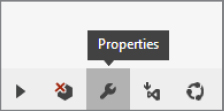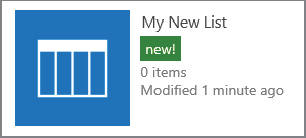REST AND ODATA
REpresentational State Transfer (REST) is a prevalent pattern for designing easily consumed data APIs over the Internet. You might hear an API described as RESTful if it is designed to be used over HTTP protocols and is in line with the principles of REST. These principles are as follows:
- Client-Server: The client is unaware of how the server stores or manages the data and doesn’t need to know in order to use the API.
- Stateless: The server does not store any context or state about the calling client.
- Cacheable: The results of the calls to the API define themselves as being cacheable, or not.
- Layered: The client does not mind whether the call to the API is transmitted via common Internet technology such as load balancers.
- Uniform Interface: This provides a simple and known way to access data through standard URI addressing and self-describing so that a client can discover how to access data.
Many services offer REST-based APIs to ease access to their systems in a commonly understood manner. SharePoint 2013 builds on this foundation to offer access in a “RESTful” way to allow remote systems to interact with it in a platform agnostic and open way. For developers this means that using other helper libraries and frameworks for working with REST is a viable method, and the time to become proficient in a proprietary API is decreased.
OData or Open Data Protocol is a protocol definition for querying, finding, and updating data over HTTP. It offers defined methods for specifying common query operations and defines the format in which data is returned. SharePoint 2013 uses WCF Data Services v5.0 which implements the OData v3 specification. For more information on OData you can visit: http://www.odata.org.
Combining a RESTful Web API with OData gives a powerful combination of simple and easy-to-use APIs that have a well-defined interface and interaction model. In practical terms, having access to a RESTful OData-based API means the following for SharePoint developers:
- Standard URIs for addressing data
- Simple use of GET, POST, PUT/MERGE, and DELETE HTTP methods
- JSON or XML (ATOM) responses
- Simple query/filter semantics
The following sections describe each of the preceding points with simple-to-follow examples of how they are addressed in SharePoint 2013’s implementation of its REST/OData Web API endpoints.
Getting Started with REST and OData
You can find SharePoint’s REST/OData APIs in the _API URL space under each SharePoint site. For example:
https://servername/sitename/_api/
_api is the root URI for all REST/OData calls. SharePoint also supports calls to the _vti_bin/client.svc/ URI to maintain backward compatibility with the previously available but more limited REST API in SharePoint 2010.
To query for data, issue a GET request. To update data you use either a PUT or MERGE request passing the data you want to update. But first you must specify which namespace it belongs in, such as Web, Site, or Search. Other groups include:
- _api/web
- _api/site
- _api/search
- _api/publishing
After you specify a namespace you must address an object, method, indexer, or property on it. Figure 9-8 depicts the URI address system.
To retrieve the list of lists on a SharePoint site simply issue a GET request to the following:
https://servername/sitename/_api/web/lists
To retrieve the details about a list simply make a GET request to that list’s URI indicated in the previous response’s id property. For example:
https://servername/sitename/_api/Web/Lists(guid'f57d3ddc-4522-4145-a0fe-72abbd6ea8fc')
This example uses the Lists method with a parameter to specify the ID of the list. You could also use the list’s entity name; for example:
https://servername/sitename/_api/Web/Lists/MoviesList
Additionally, you can address a list by name using the getbytitle function as follows. This addresses the list with its name versus its entity name:
https://servername/sitename/_api/Web/Lists/getbytitle('movies')/items
To access the items within a list add /items to the URI:
https://servername/sitename/_api/Web/Lists/MoviesList/Items
By default you will receive an ATOM feed XML response containing the lists in your site. If you want to receive a JSON payload instead, set the HTTP Accept header to application/json;odata=verbose. This signals that you want JSON instead of the default ATOM payload. JSON is typically lighter weight and better suited to mobile scenarios where speed is important.
Filtering and Selecting
When you query for data it’s important to ask for only the data you really need. This keeps payload sizes down and speeds up delivery of the data. _Api uses OData semantics to let you do this by filtering records and selecting properties you want. The common operators you can use for manipulating the result set include the following:
- $filter, for filtering results
- $select, for selecting properties to return
- $expand, for expanding properties to return
- $orderby, for ordering results
- $top, for taking the top X results
The simplest way to learn about these operations is to try them out for yourself, as shown in the following exercise.
https://servername/sitename/_api/Web/Lists/MoviesList/Items
https://servername/sitename/_api/Web/Lists/MoviesList/Items(1)
?$filter=Title eq 'Aliens'
https://servername/sitename/_api/Web/Lists/_api/Lists/ /Items? $filter=Title eq 'Aliens'&$select=Title
<?xml version="1.0" encoding="utf-8" ?> <feed xml:base="https://servername/sitename/_api/" xmlns="http://www.w3.org/2005/Atom" xmlns:d="http://schemas.microsoft.com/ado/2007/08/dataservices" xmlns:m="http://schemas.microsoft.com/ado/2007/08/dataservices/metadata" xmlns:georss="http://www.georss.org/georss" xmlns:gml="http://www.opengis.net/gml"> <id>0d01b697-f8f4-496a-bc66-81e4ab7d8208</id> <title /> <updated>2012-11-03T07:07:21Z</updated> <entry m:etag=""2""> <id>f6126125-fddb-4651-bedd-d797c6ef06f4</id> <category term="SP.Data.MoviesListItem" scheme="http://schemas.microsoft.com/ado/2007/08/dataservices/scheme" /> <link rel="edit" href="Web/Lists(guid'f57d3ddc-4522-4145-a0fe-72abbd6ea8fc')/Items(1)" /> <title /> <updated>2012-11-03T07:07:21Z</updated> <author> <name /> </author> <content type="application/xml"> <m:properties> <d:Title>Aliens</d:Title> </m:properties> </content> </entry> </feed>
?$select=Title&$orderby=Title
?$select=Title&$orderby=Title&$top=1
Creating, Updating, and Deleting
The REST endpoints also accept requests to create, update, and delete data using POST, PUT, and PATCH commands.
- POST is used for creating data
- PUT is used for updating (all property values specified)
- PATCH is used for updating (specified properties only)
When using any of the preceding commands from JS running on a SharePoint page, you also must include the form digest from the page in the appropriate HTTP header:
X-RequestDigest: formDigest
You can get the formDigest from the object returned from a POST call to /_api/contextinfo, or if you are building a SharePoint-hosted app then you can simply get the value of the formDigest with this JQuery function:
$('#__REQUESTDIGEST').val()
You are then ready to send your create, update, or delete command to SharePoint. To practice doing so, take a look at the following activity.
function getParams() {
var params = {};
location.search.split('?')[1].split('&').forEach(function (param) {
var key = param.split('=')[0],
val = decodeURIComponent(param.split('=')[1]);
params[key] = val;
});
return params;
}
var params;
var scriptbase;
function sharePointReady() {
context = new SP.ClientContext.get_current();
params = getParams();
scriptbase = params.SPHostUrl + "/_layouts/15/";
$.getScript(scriptbase + "SP.RequestExecutor.js", execCrossDomainRequest);
}
function execCrossDomainRequest()
{
var executor;
executor = new SP.RequestExecutor(params.SPAppWebUrl);
var data = JSON.stringify({ '__metadata': { 'type': 'SP.List' },
'AllowContentTypes': true, 'BaseTemplate': 100,
'ContentTypesEnabled': true, 'Description': 'My list description',
'Title': 'My New List' });
var requestUri = params.SPAppWebUrl +
"/_api/SP.AppContextSite(@target)/web/lists?@target='" + params.SPHostUrl + "'";
executor.executeAsync(
{
url: requestUri,
method: "POST",
body: data,
headers: {
"accept": "application/json;odata=verbose",
"content-type":"application/json;odata=verbose",
"content-length": data.length,
"X-RequestDigest": $('#__REQUESTDIGEST').val()
},
success: successHandler,
error: errorHandler
}
);
}
function successHandler(data) {
alert('success'),
}
function errorHandler(data, errorCode, errorMessage) {
alert("Failed :( Error:" + errorMessage);
}





